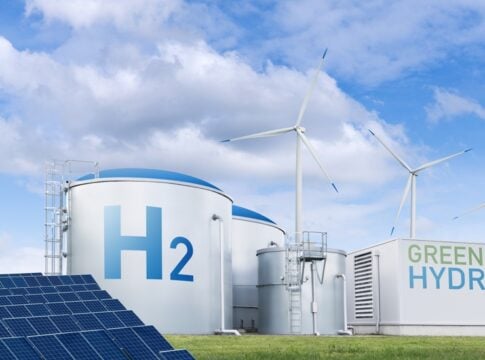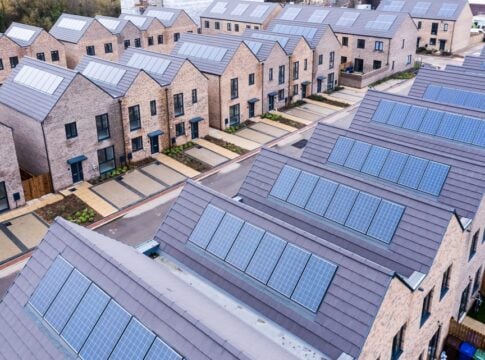What Does the New VCMI Code Mean for Carbon Credit Usage?
The carbon credit/carbon offset market has been a topic of both celebration and contention. Purchasing carbon credits can fund climate benefit projects like reforestation that ultimately help the world mitigate climate change. Yet the lack of global regulatory clarity has coincided with confusion, risk, and sometimes even deception within the voluntary carbon market.
However, new rules and universal best practices are emerging in ways that will:
- Improve quality within voluntary carbon markets
- Increase businesses’ confidence in funding climate benefit projects
- Bring clarity to consumers and other stakeholders around companies’ sustainability credentials
One of the most significant developments in this area has been the June 2023 release of the Voluntary Carbon Markets Integrity Initiative (VCMI) Claims Code of Practice. While not a panacea, this code is an important step forward toward companies being able to reliably use carbon credits in ways that are aligned with scientific best practices.
What Is the VCMI Claims Code of Practice?
Following a provisional release last year, the VCMI’s new Claims of Code of Practice specifies how businesses can make trustworthy claims related to the use of carbon credits in ways that are aligned with the Paris Agreement.
The code includes four steps to make VCMI Claims:
1) Comply with VCMI foundational criteria
To start, businesses that voluntarily comply with the code need to meet foundational criteria, such as setting science-based near-term emissions reduction targets, along with publicly committing to reaching net zero by 2050.
However, reducing emissions and reaching net zero isn’t just a matter of buying carbon credits to offset emissions. While there’s flexibility in terms of which net zero framework to use, companies have to disclose “globally recognized sustainability frameworks or guidance” they’re using, VCMI explains.
Under the Science Based Targets initiative (SBTi), for example, carbon credits don’t count as reductions in terms of reaching near-term targets. SBTi’s Corporate Net-Zero Standard also says that most companies need to cut 90% or more of emissions, and then use permanent carbon removal and storage to offset residual emissions.
2) Choose a VCMI Claim
After meeting foundational criteria, businesses can make one of three VCMI Claims. The three levels correspond to companies purchasing and retiring high-quality carbon credits equal to the following percentages of their remaining emissions for the most recent reporting year:
- VCMI Platinum: 100% or more
- VCMI Gold: 60% to < 100%
- VCMI Silver: 20% to < 60%
Again, these credits are not a substitute for emissions reductions; they must be used “to finance additional climate mitigation” while the company also works toward meeting near-term emissions reduction targets, as VCMI explains.
3) Meet Carbon Credit Usage and Quality Requirements
When using carbon credits to make VCMI Claims, companies also need to follow certain requirements. For one, carbon credits will need to be CCP-approved when available, meaning they meet the standards of the Integrity Council for the Voluntary Carbon Market (ICVCM) Core Carbon Principles.
Companies also have to disclose details about the carbon credits they use, like project IDs and methodologies.
4) Get Third-Party Assurance
Lastly, companies will need to get independent, third-party assurance that they’re meeting the requirements for making VCMI claims. This assurance will need to adhere to the VCMI Monitoring Reporting & Assurance (MRA) Framework, which is set to be published in November 2023.

What Are the Benefits of Making a VCMI Claim?
By following these rules and making VCMI claims, your business can communicate to stakeholders that you’re using carbon credits and working toward net zero in a way that’s aligned with reaching the Paris Agreement goals.
Rather than stating that your business is carbon neutral solely by way of carbon offsets, for example, you might state that your business is VCMI Platinum, signifying that you’re funding climate benefit projects while working toward science-based emissions reductions.
Taking this approach, rooted in climate science, can help win over doubters who are put off by low-quality carbon credits plaguing the voluntary carbon market.
Bad actors can sour the market, but new standards, like those set by the VCMI and ICVCM, are helping to change stakeholder perceptions while supporting important goals, like trying to limit global temperature increases to 1.5 degrees Celsius.
Part of the debate over carbon credits is that some stakeholders see global climate regulation as the only way forward. If countries and companies were aggressively regulated and taxed in order to meet the Paris Agreement goals, then the carbon credit market as we know it might not be necessary.
The reality, however, is that we’re closing in on a decade passing since the Paris Agreement. The climate picture is arguably bleaker than it was then, as evidenced by the most recent IPCC report. The political will to meet these goals in their entirety just doesn’t seem to be there, so supplements like funding climate benefit projects to meet VCMI Claims should be taken seriously.
What Will Happen to Carbon Markets Going Forward?
The new VCMI rules are an important step for carbon markets, and other organizations are also moving forward with related rules around carbon credits and climate claims.
For example, the U.S. Commodity Futures Trading Commission (CFTC) is cracking down on fraud in carbon markets, such as double counting and fraudulent statements about carbon credit terms.
While that might sound negative for carbon markets at first glance, going after bad actors could help bring confidence back to high-quality carbon credits. Highly regulated securities like publicly traded stocks give investors confidence that they’re getting what they pay for when they buy shares, and ideally the same should happen in carbon markets.
New disclosure standards from the International Sustainability Standards Board (ISSB) should also help. As part of these standards (which regulatory agencies around the world could use as a model for future regulation), companies need to disclose how carbon credits fit into any net greenhouse gas emissions targets.

So, these types of frameworks could bring further confidence to carbon markets, as consumers, investors, and others will be able to more clearly understand how carbon credits fit into a company’s operations.
Rather than assuming a company is green washing when using terms like carbon neutral, for example, they will be able to make more informed judgments.
If a business has not been able to cut emissions significantly but still invests heavily in climate benefit projects, that does not mean the business is inherently sustainable. But stakeholders at least have the clarity to decide whether they want to engage with that business vs. others that might be polluting without also giving back as much to climate mitigation efforts.
Meanwhile, businesses that can both cut emissions and fund climate benefit projects, like those that make VCMI claims, can stand out from competitors that lack the same veracity of their sustainability efforts.
Some of these rules and standards will take time to solidify, but businesses that want to get a head start on measuring, managing, and marketing their carbon footprint strategies can do so through Terrapass and our vetted, high-quality partners.
Brought to you by terrapass.com
Featured image:
The post What Does the New VCMI Code Mean for Carbon Credit Usage? appeared first on Terrapass.
Carbon Footprint
U.S. Green Hydrogen Cuts Give China an Edge in the Clean Energy Race
The United States’ push to lead in green hydrogen, once a centerpiece of its clean energy strategy, is slowing down. Recent policy changes by the Trump administration cut funding for hydrogen hubs. They also reduced tax credits for large-scale projects. Analysts say this slowdown could open the door for China to dominate the emerging market for low-carbon hydrogen technology.
The cuts mark a major shift from the previous administration’s investment-heavy approach. Under the Biden-era Inflation Reduction Act (IRA), the U.S. planned to spend billions to make hydrogen from renewable electricity. The goal was to decarbonize industries such as steel, cement, and chemicals, which are hard to electrify.
Now, with federal incentives being reduced or delayed, several projects are being reassessed. Developers worry that without consistent support, production costs will remain too high to compete globally.
Funding Cuts Stall the Hydrogen Hub Dream
In mid-2025, the U.S. Department of Energy began reviewing funding for several regional hydrogen hubs. These hubs were meant to create networks linking producers, users, and transport systems. Seven hubs were approved in 2023, backed by more than $7 billion in federal funding, but four are now facing cuts or slowdowns.
Industry groups warn that this could affect projects worth tens of billions of dollars. “Policy certainty is crucial for investors,” said one energy analyst cited in the Bloomberg report. “Every delay or rollback increases the cost of capital and slows deployment.”
The U.S. also faces uncertainty about the Section 45V hydrogen tax credit. This credit offers up to $3 per kilogram for hydrogen produced with near-zero emissions. The credit helped close the gap between costly green hydrogen and cheaper fossil-based hydrogen. Without it, the cost of producing green hydrogen in the U.S. could rise from $3 to $5 per kilogram to over $7, according to BloombergNEF estimates.
China Powers Ahead in the Hydrogen Race
While U.S. funding stalls, China is moving fast. The country already leads the world in electrolyzer manufacturing — the core technology used to make hydrogen from water. In 2024, Chinese companies supplied more than 65% of global electrolyzer capacity, up from just 40% in 2022.
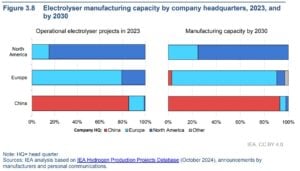
China’s domestic market is also growing. The government has set a goal to produce 200,000 tonnes of green hydrogen per year by 2025 and up to 5 million tonnes by 2030. To support this, provinces such as Inner Mongolia and Hebei have started big solar-powered hydrogen plants.
China’s advantage lies in scale and cost. Electrolyser units made in China cost $600–$1,200 per kilowatt, far lower than the $2,000–$2,600 range typical in the U.S. and Europe. If current trends continue, the price difference might make Chinese-made equipment the top choice for global projects.
Rising Costs and Shrinking Margins
Hydrogen production costs remain the biggest obstacle to global growth. The International Energy Agency (IEA) estimates that low-carbon hydrogen made with renewables costs two to four times more than conventional hydrogen from natural gas.
Producing one kilogram of green hydrogen costs between $4 and $12. This varies based on electricity prices and how efficient the electrolyzer is. Grey hydrogen, made from natural gas, costs $1–3 per kilogram. Analysts say costs must fall below $2 per kilogram to compete in most industries.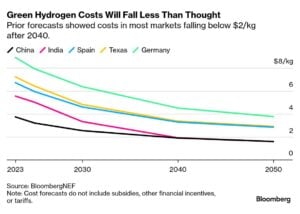
Scaling up manufacturing and securing cheap renewable power are key. The IEA projects that with large-scale deployment, electrolyzer costs could fall by 60% by 2030. But this requires steady investment and policy support — something the U.S. may now struggle to sustain.
According to BloombergNEF, global investment in hydrogen production and infrastructure reached $24 billion in 2024, up 50% from 2023. China accounted for nearly half of that total, while U.S. spending slowed after federal policy reviews.
Companies Pivot Amid Uncertainty
Despite the funding cuts, some U.S. companies are pressing ahead. Plug Power, a leading hydrogen firm, recently secured a $1.7 billion loan guarantee to expand production. The company plans to build several U.S. facilities that will supply green hydrogen to logistics and industrial customers.
Meanwhile, developers are adjusting strategies to reduce costs. Some plan to co-locate hydrogen plants near wind or solar farms to secure cheap power. Others are exploring blending hydrogen with natural gas in pipelines to reduce emissions without full conversion.
Industry leaders also call for cooperation with allies. The European Union, for example, continues to fund green hydrogen projects through its Hydrogen Bank initiative. They argue that closer cooperation across the Atlantic could help Western producers compete with China’s growing supply chain.
The Global Hydrogen Race
The race for leadership in green hydrogen is as much about geopolitics as it is about technology. Countries view hydrogen as a way to cut oil imports, boost industry, and ensure energy independence.
In 2024, global hydrogen demand reached about 97 million tonnes, according to the IEA. Only a small share — less than 1% — came from low-carbon production. To meet the world’s climate targets, that share must grow to at least 20% by 2030.
BloombergNEF expects the global hydrogen market to surpass $500 billion each year by 2050. This includes production, storage, and transport. But success depends on which countries can bring down costs first and scale up faster.
If the U.S. loses momentum now, analysts warn, it may have to rely on imported technology later — particularly from China. The following table compares the costs, market share, and 2030 planned output between the two nations.
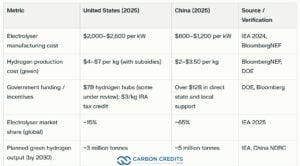
Can America Catch Up?
Green hydrogen is central to decarbonizing heavy industry and transport. It also supports renewable integration by storing excess power from wind and solar. Without continued investment, the U.S. risks missing key climate targets.
According to the Department of Energy’s earlier projections, hydrogen could cut up to 10% of U.S. greenhouse gas emissions by 2050 if widely adopted. That potential could shrink if projects slow or shift overseas.
At the same time, China’s expansion means more global supply, which could help reduce costs worldwide. Some analysts see this as an opportunity for global cooperation — if the U.S. can focus on innovation, efficiency, and regulation rather than pure scale.
The chart from Bloomberg below shows the potential changes under Trump’s current policy moves.

Experts say the U.S. can still recover its position with the right mix of policy and private investment. Restoring tax credits, simplifying permits, and investing in electrolyzer manufacturing can help create a fairer market.
For now, China appears to have the upper hand. Its rapid manufacturing growth and strong state support have created momentum that the U.S. may struggle to match. However, as clean energy technologies mature, global demand will likely outstrip any single country’s supply.
The coming years will decide whether the U.S. remains a key player or becomes a buyer in the green hydrogen market it once hoped to lead.
- FURTHER READING: Element Resources to Build America’s Largest $1.85B Green Hydrogen Plant in California
The post U.S. Green Hydrogen Cuts Give China an Edge in the Clean Energy Race appeared first on Carbon Credits.
Carbon Footprint
Fentanyl Threats, AI, and National Security – ARMR Sciences’ Unified Approach
* Disseminated on behalf of ARMR Sciences Inc.
* For Accredited Investors Only. Offered pursuant to Rule 506(c). Reasonable steps to verify accreditation will be taken before any sale.
PAID ADVERTISEMENT – SPONSORED CONTENT
Fentanyl is devastating American communities at a record pace, with more than 220 deaths every day. Synthetic opioids accounted for over 70,000 U.S. fatalities in 2023, and their impact now extends beyond public health into national security.
At the same time, artificial intelligence (AI) is advancing in ways that could allow adversaries to design new synthetic drugs or bioweapons faster than regulators and security agencies can respond. Coupled with the political weight fentanyl carries in Washington, the U.S. faces a multidimensional challenge.
ARMR Sciences underscores why prevention, innovation, and leadership can align to shield America from this emerging and evolving threat.
Escalating National Security Concerns
Fentanyl’s extraordinary potency – up to 50 times stronger than heroin – makes even trace exposure lethal. Its supply chains cross borders, complicating law enforcement and fueling instability at home.
ARMR Sciences emphasizes that enforcement alone cannot resolve the crisis. Without proactive prevention strategies, the nation risks a deepening cycle of addiction, death, and weakened resilience.
Technology at the Crossroads
AI has the potential to transform healthcare and logistics, but also carries risks of misuse. Researchers showed that advanced AI models could generate tens of thousands of psychoactive compound blueprints in just hours – a dangerous acceleration of synthetic chemistry.
National security leaders, including AI pioneers, warn that adversaries could exploit these tools. ARMR Sciences argues for robust biodefense strategies that include strict controls on sensitive algorithms, enhanced detection systems, and proactive investment in prevention technologies.
Political Pressure and Policy Response
The fentanyl crisis has become a defining issue in U.S. politics, shaping debates on border security, healthcare, and law enforcement funding. Deaths have risen by more than 20% annually since 2019, amplifying public and political demands for action.
ARMR Sciences emphasizes that bipartisan cooperation and evidence-based policymaking are essential to prevent partisan gridlock. Recognizing fentanyl as both a health and security issue can unite leaders behind more effective prevention measures.
ARMR Sciences – A Prevention-Focused Framework
Across each dimension – fentanyl’s deadly toll, AI’s potential misuse, and the political battle for solutions – ARMR Sciences underscores a common theme: prevention is the most effective defense. This means deploying early warning systems, advancing detection capabilities, integrating data-driven tools, and strengthening community resilience before crises escalate.
It also means ensuring that AI innovation develops with responsible guardrails, while national security agencies adapt to evolving synthetic threats. Prevention is not passive; it requires deliberate action, investment, and leadership.
So, Why Should Investors Pay Attention to ARMR’s Solution?
For investors, ARMR represents an opportunity to back a company working to address the convergence of fentanyl’s deadly impact, AI’s potential misuse, and the urgent need for prevention.
Its platform is built on years of defense-backed research and is advancing innovative biotechnology programs:
- Seven years of DoD-supported science established the foundation of ARMR’s platform
- Lead candidate ARMR-100 blocked 92% of fentanyl from entering the brain in preclinical (animal) studies
- A $30M private raise is currently underway
- Plans for a targeted exchange listing in 2026 are in place, subject to market conditions
By investing in this round, investors have a chance to support ARMR as it works to build a potentially category-defining role in AI-powered biodefense.
* This is a paid advertisement for ARMR’s private offering. Please read the details of the offering at InvestARMR.com for additional information on the company and the risk factors related to the offering.
* For Accredited Investors Only. This offering is made pursuant to Rule 506(c) of Regulation D. All purchasers must be accredited investors, and the issuer will take reasonable steps to verify accredited status before any sale. Investing involves high risk, including the potential loss of your entire investment.
* For investors from Canada: This advertisement forms part of the issuer’s marketing materials and is incorporated by reference into the issuer’s Offering Memorandum/Private Placement Memorandum under NI 45-106. Investors must receive and review the OM/PPM and execute the prescribed Form 45-106F4 Risk Acknowledgement before subscribing.
DISCLOSURES & DISCLAIMERS
CLIENT CONTENT: Carboncredits.com is not responsible for any content hosted on ARMR Sciences’ sites; it is ARMR Sciences’ responsibility to ensure compliance with applicable laws.
NOT INVESTMENT ADVICE: Content is for educational, informational, and advertising purposes only and should NOT be construed as securities-related offers or solicitations. All content should be considered promotional and subject to disclosed conflicts of interest.
Do NOT rely on this as personalized investment advice. Do your own due diligence.
Carboncredits.com strongly recommends you consult a licensed or registered professional before making any investment decision.
REGULATORY STATUS: Neither Carboncredits.com nor any of its owners or employees is registered as a securities broker-dealer, broker, investment advisor, or IA representative with the U.S. Securities and Exchange Commission, any state securities regulatory authority, or any self-regulatory organization.
CONTENT & COMPENSATION DISCLOSURE: Carboncredits.com has received compensation of thirty thousand dollars from ARMR Sciences for this sponsored content. You should assume we receive compensation as indicated for any purchases through links in this email via affiliate relationships, direct/indirect payments from companies or third parties who may own stock in or have other interests in promoted companies. We may purchase, sell, or hold long or short positions without notice in securities mentioned in this communication.
RESULTS NOT TYPICAL: Past performance and results are unverified and NOT indicative of future results. Results presented are NOT guaranteed as TYPICAL. Market conditions and individual circumstances vary significantly. Actual results will vary widely. Investing in securities is speculative and carries high risk; you may lose some, all, or possibly more than your original investment.
HIGH-RISK: Securities discussed may be highly speculative investments subject to extreme volatility, limited liquidity, and potential total loss. The Securities are suitable only for persons who can afford to lose their entire investment. Furthermore, investors must understand that such investment could be illiquid for an indefinite period of time. No public market currently exists for the securities, and if a public market develops, it may not continue.
CAUTIONARY STATEMENT: Certain statements in this presentation (the “Presentation”) may be deemed to be “forward-looking statements” within the meaning of Section 27A of the 1933 Securities Act and Section 21E of the Exchange Act of 1934, as amended, and are intended to be covered by the safe harbor provisions for forward-looking statements. Such forward-looking statements can be identified by the use of words such as ”should,” ”may,” ”intends,” ”anticipates,” ”believes,” ”estimates,” ”projects,” ”forecasts,” ”expects,” ”plans,” and ”proposes.” Forward-looking statements, which are based on the current plans, forecasts and expectations of management of ARMR Sciences Inc. (the “Company” or “ARMR Sciences”), are inherently less reliable than historical information. Forward-looking statements are subject to risks and uncertainties, including events and circumstances that may be outside our control.
Although management believes that the expectations reflected in these forward-looking statements are based on reasonable assumptions, there are a number of risks and uncertainties that could cause actual results to differ materially from such forward-looking statements. Risks and uncertainties that could cause actual results to differ materially include, without limitation, those risks identified in the Private Placement Memorandum. Forward-looking statements speak only as of the date of the document in which they are contained, and ARMR Sciences Inc. does not undertake any duty to update any forward-looking statements except as may be required by law.
Any forward-looking financial forecasts contained in this Presentation are subject to a number of risks and uncertainties, and actual results may differ materially. You are cautioned not to place undue reliance on such forecasts. No assurances can be given that the future results indicated, whether expressed or implied, will be achieved. While sometimes presented with numerical specificity, all such forecasts are based upon a variety of assumptions that may not be realized, and which are highly variable. Because of the number and range of the assumptions underlying any such forecasts, many of which are subject to significant uncertainties and contingencies that are beyond the reasonable control of the issuing company, many of the assumptions inevitably will not materialize and unanticipated events and circumstances may occur subsequent to the date of any financial forecast.
ARMR Sciences Inc. takes no responsibility for any forecasts contained within the Presentation. None of the information contained in any offering materials should be regarded as a representation by ARMR Sciences Inc. The Company’s forecasts have not been prepared with a view toward public disclosure or compliance with the guidelines of the SEC, the American Institute of Certified Public Accountants or the Public Company Accounting Oversight Board. Independent public accountants have not examined nor compiled any forecasts and have not expressed an opinion or assurance with respect to the figures.
This Presentation also contains estimates and other statistical data made by independent parties and by management relating to market size and other data about our industry. This data involves a number of assumptions and limitations, and you are cautioned not to give undue weight to such estimates.
ARMR Sciences Inc. is currently undertaking a private placement offering of Offered Shares pursuant to Section 4(a)(2) of the 1933 Act and/or Rule 506(c) of Regulation D promulgated thereunder. Investors should consider the investment objectives, risks, and investment time horizon of the Company carefully before investing. The private placement memorandum relating to the offering of Securities will contain this and other information concerning the Company, including risk factors, which should be read carefully before investing.
The Securities are being offered and sold in reliance on exemptions from registration under the 1933 Act. In accordance therewith, you should be aware that (i) the Securities may be sold only to “accredited investors,” as defined in Rule 501 of Regulation D; (ii) the Securities will only be offered in reliance on an exemption from the registration requirements of the Securities Act and will not be required to comply with specific disclosure requirements that apply to registration under the Securities Act; (iii) the United States Securities and Exchange Commission (the “SEC”) will not pass upon the merits of or give its approval to the terms of the Securities or the offering, or the accuracy or completeness of any offering materials; (iv) the Securities will be subject to legal restrictions on transfer and resale and investors should not assume they will be able to resell their securities; and (v) investing in these Securities involves a high degree of risk, and investors should be able to bear the loss of their entire investment. Furthermore, investors must understand that such investment could be illiquid for an indefinite period of time.
The Company is “Testing the Waters” under Regulation A under the Securities Act of 1933. The Company is not under any obligation to make an offering under Regulation A. No money or other consideration is being solicited in connection with the information provided, and if sent in response, will not be accepted. No offer to buy the securities can be accepted and no part of the purchase price can be received until an offering statement on Form 1-A has been filed and until the offering statement is qualified pursuant to Regulation A of the Securities Act of 1933, as amended, and any such offer may be withdrawn or revoked, without obligation or commitment of any kind, at any time before notice of its acceptance given after the qualification date.
The securities offered using Regulation A are highly speculative and involve significant risks. The investment is suitable only for persons who can afford to lose their entire investment. Furthermore, investors must understand that such investment could be illiquid for an indefinite period of time. No public market currently exists for the securities, and if a public market develops following the offering, it may not continue. The Company intends to list its securities on a national exchange and doing so entails significant ongoing corporate obligations including but not limited to disclosure, filing and notification requirements, as well compliance with applicable continued quantitative and qualitative listing standards.
Disclosure: Owners, members, directors, and employees of carboncredits.com have/may have stock or option positions in any of the companies mentioned: None.
Carboncredits.com receives compensation for this publication and has a business relationship with any company whose stock(s) is/are mentioned in this article.
Additional disclosure: This communication serves the sole purpose of adding value to the research process and is for information only. Please do your own due diligence. Every investment in securities mentioned in publications of carboncredits.com involves risks that could lead to a total loss of the invested capital.
Please read our Full RISKS and DISCLOSURE here.
The post Fentanyl Threats, AI, and National Security – ARMR Sciences’ Unified Approach appeared first on Carbon Credits.
Carbon Footprint
Solar Now the World’s Cheapest Energy, Powering the Clean Transition
Solar energy has officially claimed the title of the world’s most affordable source of electricity. According to new research from the University of Surrey’s Advanced Technology Institute (ATI), solar power now costs as little as £0.02 per kilowatt-hour in the sunniest regions.
The study, published in Energy and Environmental Materials, highlights how solar photovoltaic (PV) technology has transformed from a niche innovation into the backbone of the global clean energy revolution.
As countries race to cut carbon emissions and combat climate change, the rapidly falling cost of solar power is unlocking access to clean energy on an unprecedented scale.
Solar Becomes the Cornerstone of a Low-Carbon Future
Professor Ravi Silva, co-author of the study and Director of the ATI, emphasized that even in less sunny nations like the UK, solar power has become the most cost-effective option for large-scale generation.
He precisely noted,
“Even here in the UK, a country that sits 50 degrees north of the equator, solar is the cheapest option for large-scale energy generation. Globally, the total amount of solar power installed passed 1.5 terawatts in 2024 – twice as much as in 2020 and enough to power hundreds of millions of homes. Simply put, this technology is no longer a moonshot prospect but a foundational part of the resilient, low-carbon energy future that we all want to bring to reality.”
This milestone shows that solar energy is no longer experimental. It’s a proven cornerstone of the low-carbon future the world is building toward.
Alongside solar, the cost of lithium-ion batteries—key to storing renewable power—has dropped by a staggering 89% since 2010. This sharp decline has made solar-plus-storage systems a competitive alternative to conventional gas-fired power plants.
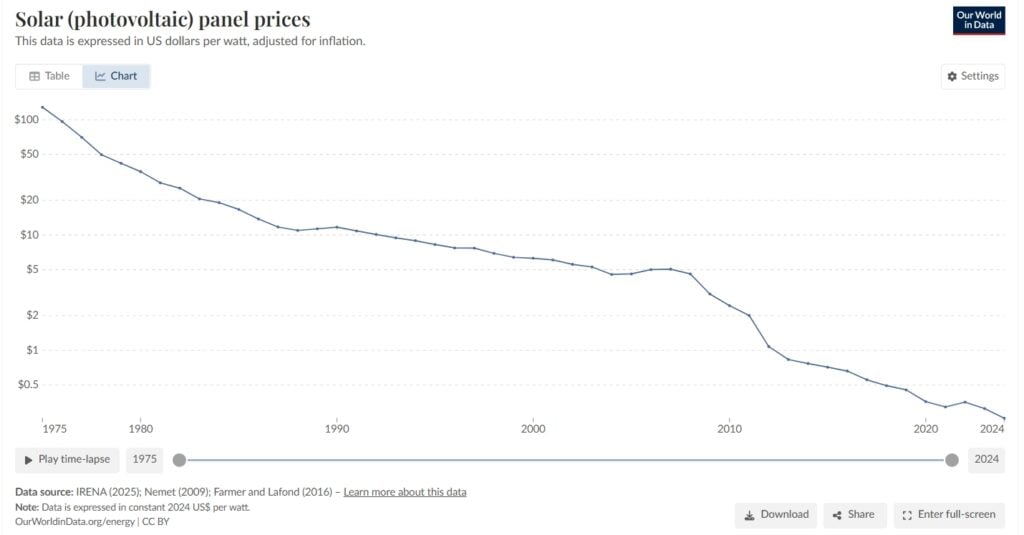
Global Solar Costs Fall Over 80% in a Decade
According to the International Renewable Energy Agency (IRENA), the global weighted-average levelized cost of electricity (LCOE) for utility-scale solar PV dropped by over 80% between 2010 and 2023. In sun-rich regions, it now costs as little as $0.03 per kilowatt-hour—making it the cheapest source of new electricity generation worldwide.
This steep decline stems from a mix of technological, economic, and policy factors. Breakthroughs in solar cell efficiency, bifacial modules, and tracking systems have dramatically boosted energy output.
China’s Role in Falling Clean Energy Costs
Meanwhile, bigger economies, especially from large-scale manufacturing in China, have lowered hardware and installation costs.
Bloomberg also expects the cost of clean energy technologies, i.e., solar, wind, and battery storage, to drop further in 2025. It could be falling 2–11% and breaking last year’s records. In almost every part of the world, new solar and wind farms are now cheaper to build and operate than new coal or gas plants
Significantly, China’s overcapacity in clean tech has led some countries to impose import tariffs, temporarily slowing cost declines. Still, BNEF expects levelized costs for clean energy to fall 22–49% by 2035, keeping renewables on track for long-term growth.
- Battery storage costs dropped a third in 2024 to $104/MWh, driven by oversupply from slower EV sales, with prices expected to cross $100/MWh in 2025.
- Fixed-axis solar farms fell 21% globally, while wind and solar generation costs are projected to decline another 4% and 2%. It ensures clean energy remains cheaper than fossil fuels.
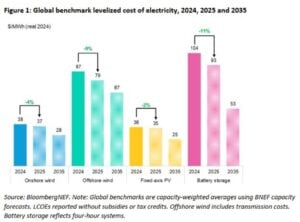
- ALSO READ: Renewable Energy Investment Reaches Record High as China Operates World’s Biggest Solar Farm
Storage Revolution: Solar Power Around the Clock
The global energy storage boom has turned solar from an intermittent resource into a 24-hour power solution. It’s because of the massive cost reductions in batteries, solar-plus-storage systems can now compete head-to-head with gas-fired plants.
However, challenges remain in connecting large volumes of solar power to existing grids. Regions like California and China have already experienced energy curtailment due to grid congestion when solar output exceeds demand.
Dr. Ehsan Rezaee, co-author of the University of Surrey study, noted that “smart grids, artificial intelligence forecasting, and stronger regional interconnections will be essential to maintain power system stability as renewable adoption grows.”
Global Policy Boosts vs. U.S. Uncertainty
Supportive policy frameworks are key to sustaining solar’s momentum. In Europe, the Green Deal and RePowerEU initiatives have simplified permitting and set aggressive renewable targets.
India’s Production Linked Incentive (PLI) scheme, meanwhile, is strengthening local solar manufacturing to reduce dependence on imports. These measures are not only cutting carbon emissions but also advancing energy security, job creation, and economic growth.
International partnerships, such as the International Solar Alliance (ISA), continue to drive collaboration, knowledge exchange, and capacity building, particularly in developing nations that stand to benefit most from affordable solar energy.
OBBBA: Dimming the Sunshine
However, the story is slightly different in the U.S. In July 2025, President Trump signed the One Big Beautiful Bill Act (OBBBA), which speeds up the phase-out or early termination of most renewable energy tax credits and clean energy incentives established under the IRA.
As a result, U.S. clean energy incentives are being rapidly scaled back, with many tax credits set to expire or face new restrictions and deadlines, creating significant uncertainty for investors and project developers.
Breakthrough Technologies Drive the Next Wave
Solar technology innovation is accelerating at record speed. Researchers at the University of Sydney recently achieved a world-first breakthrough with a 16 cm² triple-junction perovskite solar cell delivering 23.3% efficiency for large-area devices. A smaller version reached 27.06% efficiency—the highest globally—and retained 95% performance after 400 hours of continuous operation.
Perovskite solar cells could revolutionize the market by boosting energy output by up to 50% without expanding land use. They can be made as thin, flexible films at lower temperatures than traditional silicon panels, cutting production costs significantly. Over the past decade, perovskite efficiency has soared from 3% to over 25%, with tandem cells poised to exceed 30%. These innovations will further drive down solar costs and expand applications across rooftops, vehicles, and portable systems.
Solar Dominates Future Renewable Growth
The International Energy Agency (IEA) forecasts that global renewable capacity will double by 2030—adding 4,600 gigawatts (GW), equivalent to the combined power generation capacity of China, the EU, and Japan.
- Solar PV will account for nearly 80% of this growth, followed by wind, hydropower, and bioenergy.

According to DNV’s latest Energy Transition Outlook, global solar capacity is expected to surpass 3,000 GW by the end of 2025, with China holding 47% and Europe 20%. It further highlights:
- Solar already generates about 10% of the world’s electricity and is projected to reach 20% by 2029 and 40% by 2045.
- Behind-the-meter (BTM) solar used by households and businesses is also on the rise and is expected to make up 30% of total solar generation by 2060.
- Wind power is projected to nearly double to over 2,000 GW by 2030, but solar remains the lowest-cost option in most markets.
India is emerging as the second-fastest renewables market after China, advancing its 2030 targets. Expanded auctions and rapid rooftop solar growth contribute to the solar boom.
However, the world still falls short of the COP28 goal to triple renewable capacity by 2030, achieving about a 2.6-fold increase from 2022 levels. Closing this gap will require continued investment, innovation, and political will.
Building a Resilient Solar Future
As solar continues to dominate the global energy landscape, integration challenges must not be ignored. Expanding transmission networks, deploying digital grid management tools, and investing in advanced materials will be crucial.
Professor Silva emphasizes that sustained policy backing and continued innovation will determine how quickly the world transitions to a clean, resilient energy future.
The Renewable Energy Institute applauds solar’s rise as the cheapest source of electricity and continues to provide accredited training to build the skills needed to sustain this momentum.
Thus, from record-low costs to record-breaking efficiency, solar energy is reshaping the global energy system faster than anyone imagined. Its combination of affordability, scalability, and innovation is driving the clean energy transition forward.
The question now isn’t if solar will dominate, but how quickly the world can harness its full potential.
The post Solar Now the World’s Cheapest Energy, Powering the Clean Transition appeared first on Carbon Credits.
-
Climate Change2 years ago
Spanish-language misinformation on renewable energy spreads online, report shows
-
Climate Change2 months ago
Guest post: Why China is still building new coal – and when it might stop
-
Climate Change Videos2 years ago
The toxic gas flares fuelling Nigeria’s climate change – BBC News
-

 Greenhouse Gases1 year ago
Greenhouse Gases1 year ago嘉宾来稿:满足中国增长的用电需求 光伏加储能“比新建煤电更实惠”
-
Greenhouse Gases2 months ago
Guest post: Why China is still building new coal – and when it might stop
-

 Climate Change1 year ago
Climate Change1 year ago嘉宾来稿:满足中国增长的用电需求 光伏加储能“比新建煤电更实惠”
-

 Carbon Footprint2 years ago
Carbon Footprint2 years agoUS SEC’s Climate Disclosure Rules Spur Renewed Interest in Carbon Credits
-
Renewable Energy3 months ago
US Grid Strain, Possible Allete Sale

